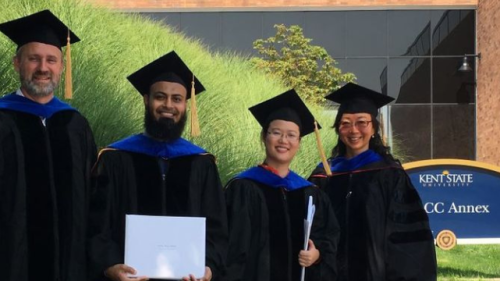He Yin, Ph.D., assistant professor in Kent State University’s Department of Geography in the College of Arts and Sciences, recently received NASA’s New (Early Career) Investigator Award in Earth Science. The award will provide funding for Yin’s research on the effects of the Syrian civil war on croplands throughout the eastern Mediterranean region.
The civil war in Syria, which has now lasted for a decade, began when the Syrian government used deadly force to suppress pro-democracy demonstrations and has left more than 500,000 people killed or missing and more than 11 million displaced. In the wake of fighting more than thousands of structures have been destroyed, countless historical sites have been damaged and miles of land abandoned or ruined. 1
Through his research, Yin hopes to develop in-demand remote sensing algorithms to track cropland changes over time and create a general approach to detect the timeline of cropland developments.
“These war tactics produce tragic consequences that have affected cropland production,” Yin said. “Civilians depend on successful crop production for food security and economic stability while amidst a war zone.
“It’s anticipated that the Syrian civil war has caused mass amounts of cropland loss, but other factors such as drought may have also affected cropland,” Yin continued. “The more we research, the more we understand the effects of ongoing warfare throughout the cropland.
“Croplands in the Mediterranean are diverse and dynamic, which poses challenges for remote sensing,” Yin said.
Remote sensing is a great tool to monitor cropland, especially in war-torn areas where ground measurements are impossible. In the field of GIS, remote sensing uses sensors which are installed on satellites or mounted on aircraft or drones so that they can take measurements on the earth. Remote sensing is possible because every object has its own spectral signature, which is the amount of reflected energy in a certain wavelength within the electromagnetic spectrum (EMS). This reflected energy is dependent on the object’s chemical composition.
By examining this topic, Yin hopes his research will advance cropland mapping through the use of remote sensing algorithms and help understand the war’s effects on crops. Yin’s work will also help solve issues pertaining to food insecurity within the war zones and provide additional insight into environmental change.
“Understanding the devastation caused by war is crucial to advance humanitarian support,” Yin said.
About Assistant Professor He Yin, Ph.D.
Yin states his research interests are utilizing remote sensing and geospatial techniques for environmental monitoring and assessment and specifically using satellite imagery time series and GIS spatial analysis, focusing on land use and land cover change. Yin is the Principal Investigator of the SensLand Lab at Kent State University which focuses on remote sensing, spatial analysis, and modeling approaches to better understand how humans have transformed land systems.2
Yin earned his PhD degree in Geography at the Humboldt University of Berlin and was a Postdoctoral Research Associate at the University of Wisconsin-Madison, where he collaborated on several NASA Land-Cover Land-Use Change programs and a NASA Citizen Science for Earth Systems program. He also performed postdoctoral research at the University of Bonn where he worked on a study for the Center for International Forestry Research.
The NASA New Investigator Award and Earth Science Division
NASA’s New (Early Career) Investigator Program (NIP) is designed to support outstanding scientific research and career development of scientists and engineers at the early stage of their professional careers. This single-investigator program solicits proposals every two years that advance NASA’ mission to drive advances in science, technology, aeronautics, and space exploration to enhance knowledge, education, innovation, economic vitality, and stewardship of Earth.
NASA’s Earth Science Division (ESD) missions help uncover the earth’s interconnected systems, from a global scale down to minute processes. ESD delivers the technology, expertise, global observations, and applications that help map the myriad connections between the planet’s vital processes and the climate effects of ongoing natural and human-caused changes.3
Sources
- Retrieved on November 26, 2021, from bbc.com/news/world-middle-east-35806229
- Retrieved on November 26, 2021, from senslandlab.com
- Retrieved on November 26, 2021, from science.nasa.gov/earth-science




